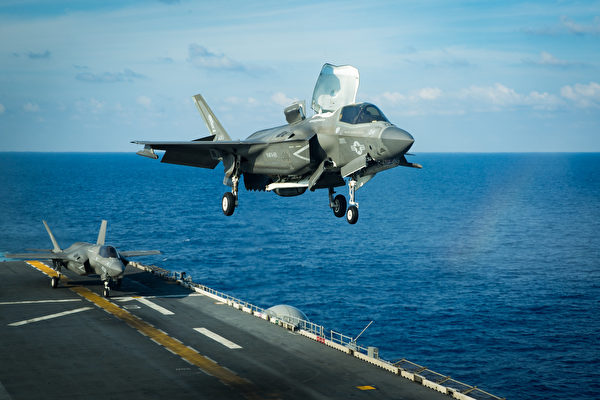In potential conflicts between the US and the Chinese Communist regime in the Indo-Pacific region, American aircraft carriers will play a crucial role. A senior US military official stated that the US Navy is modifying the USS Bataan, a former “Harrier carrier,” and other amphibious assault ships to carry F-35B Lightning II fighter jets, which will change the “game rules.”
Aircraft carriers are key in potential conflicts in the Indo-Pacific where the US and China could face off. Currently, despite China’s larger number of naval ships and personnel, the US Navy holds a clear advantage in terms of aircraft carriers.
The US Navy can deploy 11 supercarriers, while China has only two (with a third undergoing testing) that have not undergone the same mission-ready training as US supercarriers globally. Furthermore, the 10 Nimitz-class and 1 Ford-class carriers in the US Navy have better combat capabilities than China’s carriers, one of which is a refurbished former Soviet carrier. The US Navy undeniably has the upper hand.
To further enhance this advantage, the US Navy is converting ships like the USS Bataan into “lightning carriers” capable of deploying F-35B aircraft. These modifications, including reinforced decks and new electrical systems, will enhance the Navy’s operational flexibility without the need for additional supercarriers.
The USS Bataan, a Wasp-class amphibious assault ship, is one of the main vessels for amphibious operations in the US military. In service since September 1997, it is the world’s largest and carries the most aircraft of any amphibious assault ship currently.
The number of aircraft carried by a “lightning carrier,” unlike a supercarrier (which can carry over 50 aircraft), is fewer but cost-effective compared to building a new aircraft carrier, offering greater versatility.
The US Navy can amass more aircraft carriers in the form of amphibious assault ships. These ships are designed to support Marine Corps amphibious operations, capable of carrying a squadron of F-35B stealth fighters, similar to the Casablanca-class light carriers used by the Navy in World War II, each carrying about 27 aircraft.
The F-35B is the short takeoff and vertical landing (STOVL) version of the F-35, capable of taking off and landing like a helicopter. This STOVL capability is well-suited for expeditionary operations with limited space and resources, without the need for catapult launch systems on Nimitz-class and Ford-class aircraft carriers.
The upcoming overhaul of the USS Bataan signifies the Navy’s aim to expand its overall aircraft carrier fleet without adding new supercarriers.
According to the Navy, the conversion process will take approximately 1.5 years for the USS Bataan to be combat-ready.
Reformatted to enhance F-35B vertical takeoff and landing operations, alongside reinforced decks, the USS Bataan requires new electrical systems to meet the demands of the latest aircraft, according to Rear Admiral Brian Cavanaugh, Marine Corps Forces Command.
This upgrade will enable the USS Bataan to deploy fifth-generation F-35 aircraft while maintaining vital amphibious assault capabilities. These smaller ships conduct a variety of missions.
The USS Bataan previously participated in operations against Houthi rebels in the Red Sea.
Commander Trace Head mentioned at the Fleet Week event in New York that once the USS Bataan can effectively carry F-35s, it will become one of the most advanced amphibious warships in the Navy.
He noted that the capability gained when the USS Bataan can effectively deploy F-35s, especially from an air-to-air perspective, will be highly advanced, effectively changing the game rules.
Admiral Cavanaugh emphasized that transitioning to the F-35 will be a significant leap, bringing new capabilities to the fleet and generating a more potent deterrence globally as technologies integrate.
Experts have been debating the usefulness of lightning carriers in conflicts against major powers like China. Some views suggest US allies like Australia, Japan, and South Korea are advancing similar concepts at various stages.
A significant advantage of a lightning carrier lies in the advanced sensor array of the F-35B, enabling the aircraft to act as a battlefield pivot and relay information to allied forces over wide areas.
The America-class of amphibious assault ships is a reboot of the Wasp-class, capable of carrying F-35B aircraft.
The LHA-7 Tripoli, the second ship of the America-class, embarked with 16 F-35Bs in April 2022. Days later, the number increased to 20, with a maximum capacity of 22 F-35Bs, surpassing the combat capability of Russia’s only carrier, the Admiral Kuznetsov, which can carry up to 24 Su-33 and MiG-29K jets.
In December 2022, Admiral Karl Thomas of the US Seventh Fleet stated that US lightning carriers have far greater abilities compared to China’s existing carriers, whether in sortie rates or pure capabilities.
On an earlier occasion in April, the Japanese Maritime Self-Defense Force completed the first special modifications for the Kaga, showcasing the redesigned flight deck designed to operate and launch F-35 aircraft.

